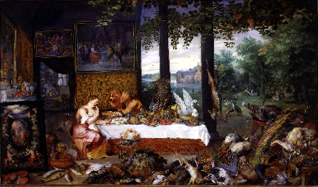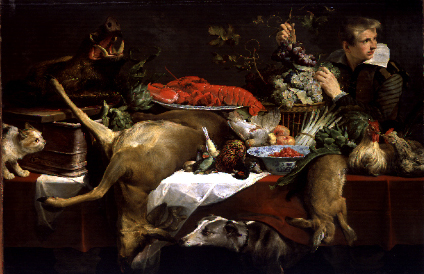


The point of departure for Taste is the Archdukes’ table: Frans Snyders’ Pantry with Game and Serving Boy (Munich, Alte Pinakothek). This section will not, however, be limited to an explication of the food and drink in the paintings of Snyders and other artists. It also includes what would then be thought of as ‘good taste’, lifestyles which reflected Habsburg values and were therefore considered as examples to be followed by society.

The hunting scenes, for instance, refer to the archducal hunting edict, which made a clear distinction between who was and who was not permitted to hunt noble game. As such the Court disseminated an ideal model of South-Netherlandish society, for which it served as a mirror. Courtly lifestyles, habits, preferences, and suchlike were closely imitated by the different social classes.
| The civilising mission is illustrated at three levels: the Court, the cities and the countryside. For the countryside Brueghel’s various rural scenes serve as excellent illustrations: his Peasant Dance in the Presence of the Archdukes (Madrid, Prado) and his and his Peasant Wedding in the Presence of the Archdukes (Madrid, Prado). |
| The ‘civilisation’ of the nobility is reflected in the Portrait of the Arenberg family (Leuven, University Collection). For the urban civilising offensive an attempt will be made to reunite Denijs van Alsloot’s series The Ommeganck of 1615 (Brussels, KMSK; London, Victoria & Albert Museum; Madrid, Prado). Further pieces will primarily be those produced by or for fraternities: goblets, chains of office, breastplates, collars, registers, etc., with archducal insignia. | |
The anonymous Isabella at the Shooting Competition of the Ghent Guild of St George (Ghent, Museum van de Bijloke) will round off this theme.
 |
 |
 |